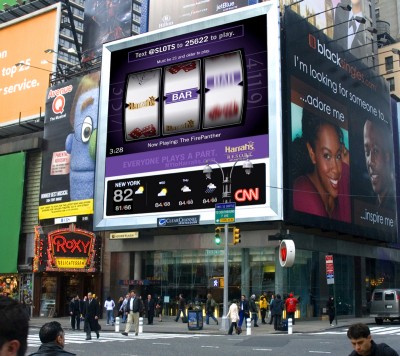Digital signage already adds interactive marketing dynamics to many public places, but by being teamed with mobile devices, the scope of that marketing can be expanded further, offering more spontaneous and direct communications. Not only can branding efforts be enhanced, but from the consumer’s perspective, there are opportunities for user-generated content to be delivered to digital signage.
“Mobile-driven digital signage affords a higher level of interactivity that didn’t exist before,” says Jeremy Lockhorn, vice-president (VP) of the emerging media practice (EMP) at Razorfish, a marketing and advertising agency with offices across North America and Europe, as well as in Brazil, Australia, China and Japan. “Mobile devices are becoming the ultimate remote control. They have the capability to build bridges to other media.”

 Working in partnership with Clear Channel Spectacolor, LocaModa has launched games like Jumbli (bottom) and a Harrah’s slot machine (top) on a digital screen at New York’s Times Square. Passersby played these games by using their mobile phones. Photos courtesy LocaModa
Working in partnership with Clear Channel Spectacolor, LocaModa has launched games like Jumbli (bottom) and a Harrah’s slot machine (top) on a digital screen at New York’s Times Square. Passersby played these games by using their mobile phones. Photos courtesy LocaModa
Lockhorn advises taking care, however, when exploiting these new media options.
“You need a clear and well-defined strategy,” he says, “and not all brands or products lend themselves to mobile campaigns.”
It is also important to offer something to the busy consumer.
“To succeed, mobile signage campaigns must offer either clear entertainment or monetary value,” says Dan Trigub, chief development officer for Blue Bite, which delivers digital content to phones within select zones. “There should be unique content designed for mobile users, such as digital coupons or behind-the-scenes movie trailers.”
One relatively new trend in mobile-driven digital signage is offering downloads of mobile apps. A DOOH campaign developed by Blue Bite and RMG Networks, for example, promoted an app for business travellers using screens in airports. This way, the app was showcased in a contextually relevant environment.
Increasing accountability
One of the reasons advertiser interest has grown is accountability, as interactivity allows customer feedback. Measuring systems are particularly well-established for Short Message Service (SMS), proximity-based downloads and the scanning of bar codes and Quick Response (QR) codes.
“There is greater accountability than was previously possible in public spaces,” says Lockhorn. “The applications are more valuable from a return on investment (ROI) perspective, as they have been shown to increase brand awareness significantly.”
“The more highly interactive the campaign, the greater the data,” says Trigub. “While traditional brand impression measurements have value, they do not offer the level of accountability providing by actual user actions, such as downloads prompted by a call to action.”
One of the earliest examples of successful interactive mobile marketing in public places was the Vodafone Cube, a 4 x 4-m (1.2 x 1.2-ft) structure that debuted in Lisbon, Portugal, back in 2002. Developed by YDreams, a local interactive technology company, it targeted both visitors and employees at Vodafone’s Lisbon headquarters, allowing them to interact with multiplayer games, product demonstrations, videos and other content displayed on a large screen.
To accomplish this interactivity, users had to call a number shown on the screen, which routed them through a digital audio switchboard to a computer server. Once connected, they joined a real-time game with up to four participants in total. According to YDreams, hundreds of people interacted with the Cube’s content each day.
In 2008, BlueFire gathered user response feedback to a mobile-driven digital signage project it conducted with Sha Keb Consultancy on two weeknights at an upscale bar in Sacramento, Calif. The project involved a bar employee taking photos of patrons with his cell phone and sending them via Multimedia Messaging Service (MMS) to screens, where they were displayed along with text messages sent by viewers.
Starting at 10 p.m. on each of the nights, the content was run continuously for four hours. The project involved three displays, one of which was projected behind the bar.





